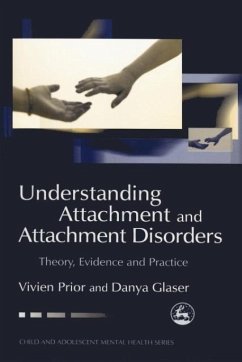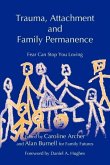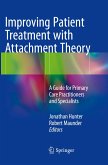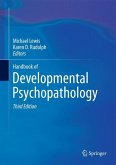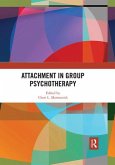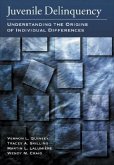Vivien Prior, Danya Glaser
Understanding Attachment and Attachment Disorders
Theory, Evidence and Practice
Vivien Prior, Danya Glaser
Understanding Attachment and Attachment Disorders
Theory, Evidence and Practice
- Broschiertes Buch
- Merkliste
- Auf die Merkliste
- Bewerten Bewerten
- Teilen
- Produkt teilen
- Produkterinnerung
- Produkterinnerung
This book offers a thorough examination and discussion of the evidence on attachment, its influence on development, and attachment disorders. Summarising the existing knowledge base in accessible language, this is a comprehensive reference book for professionals including social workers, psychologists, psychiatrists, teachers, and researchers.
Andere Kunden interessierten sich auch für
![Trauma, Attachment and Family Permanence Trauma, Attachment and Family Permanence]() John QuickeTrauma, Attachment and Family Permanence37,99 €
John QuickeTrauma, Attachment and Family Permanence37,99 €![Improving Patient Treatment with Attachment Theory Improving Patient Treatment with Attachment Theory]() Improving Patient Treatment with Attachment Theory60,99 €
Improving Patient Treatment with Attachment Theory60,99 €![Handbook of Developmental Psychopathology Handbook of Developmental Psychopathology]() Handbook of Developmental Psychopathology335,99 €
Handbook of Developmental Psychopathology335,99 €![The Routledge International Handbook of Clinical Hypnosis The Routledge International Handbook of Clinical Hypnosis]() The Routledge International Handbook of Clinical Hypnosis205,99 €
The Routledge International Handbook of Clinical Hypnosis205,99 €![Attachment in Group Psychotherapy Attachment in Group Psychotherapy]() Attachment in Group Psychotherapy39,99 €
Attachment in Group Psychotherapy39,99 €![Addictions From an Attachment Perspective Addictions From an Attachment Perspective]() Richard GillAddictions From an Attachment Perspective25,99 €
Richard GillAddictions From an Attachment Perspective25,99 €![Juvenile Delinquency: Understanding the Origins of Individual Differences Juvenile Delinquency: Understanding the Origins of Individual Differences]() Vernon L. QuinseyJuvenile Delinquency: Understanding the Origins of Individual Differences21,99 €
Vernon L. QuinseyJuvenile Delinquency: Understanding the Origins of Individual Differences21,99 €-
-
-
This book offers a thorough examination and discussion of the evidence on attachment, its influence on development, and attachment disorders. Summarising the existing knowledge base in accessible language, this is a comprehensive reference book for professionals including social workers, psychologists, psychiatrists, teachers, and researchers.
Produktdetails
- Produktdetails
- Verlag: Jessica Kingsley Publishers, Ltd
- Seitenzahl: 290
- Erscheinungstermin: 1. Februar 2006
- Englisch
- Abmessung: 229mm x 152mm x 16mm
- Gewicht: 424g
- ISBN-13: 9781843102458
- ISBN-10: 1843102455
- Artikelnr.: 21847418
- Herstellerkennzeichnung
- Libri GmbH
- Europaallee 1
- 36244 Bad Hersfeld
- gpsr@libri.de
- Verlag: Jessica Kingsley Publishers, Ltd
- Seitenzahl: 290
- Erscheinungstermin: 1. Februar 2006
- Englisch
- Abmessung: 229mm x 152mm x 16mm
- Gewicht: 424g
- ISBN-13: 9781843102458
- ISBN-10: 1843102455
- Artikelnr.: 21847418
- Herstellerkennzeichnung
- Libri GmbH
- Europaallee 1
- 36244 Bad Hersfeld
- gpsr@libri.de
Vivien Prior and Danya Glaser
1. Introduction. Part One: Attachment and Caregiving. 2. What is
Attachment? 3. The Classifications of Attachment. 4. What are the Factors
Influencing Attachment Organisation (and Disorganisation)? 5. Affectional
Bonds and Attachment Figures. 6. Is Attachment Theory Valid across
Cultures? Part Two: Assessments of Attachment and Caregiving. 7.
Introduction. 8. Assessments of Attachment. 9. Assessments of Caregiving.
Part Three: Correlates of Attachment Organisation with Functioning. 10.
Which Domains of Functioning are Hypothesised to be Correlated with
Attachment and What are the Possible Pathways of its Influence? 11.
Evidence for Correlations between Attachment Security/Insecurity and the
Child's Functioning. Part Four: What is Attachment Disorder? 12. Two
Versions of Attachment Disorder. 13. Research on Attachment Disorder. 14.
The Nature of Attachment Disorder. Part Five: Attachment Theory-based
Interventions (and Some that are Not). 15. Introduction. 16. Evidence-based
Interventions: Enhancing Caregiver Sensitivity. 17. Evidence-based
Interventions: Change of Caregiver. 18. Interventions with No Evidence
Base. 19. Conclusions Regarding Interventions. References. Index. About
FOCUS.
Child and Adolescent Mental Health Series
Written for professionals, and parents, these accessible, evidence-based
resources are essential reading for anyone seeking to understand and
promote children and young people's mental health. Drawing on the work of
FOCUS, a multidisciplinary project based at the Royal College of
Psychiatrists' Research and Training Unit, each title in the series brings
together practical and policy-level suggestions with up-to-the minute
analysis of research.
Attachment? 3. The Classifications of Attachment. 4. What are the Factors
Influencing Attachment Organisation (and Disorganisation)? 5. Affectional
Bonds and Attachment Figures. 6. Is Attachment Theory Valid across
Cultures? Part Two: Assessments of Attachment and Caregiving. 7.
Introduction. 8. Assessments of Attachment. 9. Assessments of Caregiving.
Part Three: Correlates of Attachment Organisation with Functioning. 10.
Which Domains of Functioning are Hypothesised to be Correlated with
Attachment and What are the Possible Pathways of its Influence? 11.
Evidence for Correlations between Attachment Security/Insecurity and the
Child's Functioning. Part Four: What is Attachment Disorder? 12. Two
Versions of Attachment Disorder. 13. Research on Attachment Disorder. 14.
The Nature of Attachment Disorder. Part Five: Attachment Theory-based
Interventions (and Some that are Not). 15. Introduction. 16. Evidence-based
Interventions: Enhancing Caregiver Sensitivity. 17. Evidence-based
Interventions: Change of Caregiver. 18. Interventions with No Evidence
Base. 19. Conclusions Regarding Interventions. References. Index. About
FOCUS.
Child and Adolescent Mental Health Series
Written for professionals, and parents, these accessible, evidence-based
resources are essential reading for anyone seeking to understand and
promote children and young people's mental health. Drawing on the work of
FOCUS, a multidisciplinary project based at the Royal College of
Psychiatrists' Research and Training Unit, each title in the series brings
together practical and policy-level suggestions with up-to-the minute
analysis of research.
1. Introduction. Part One: Attachment and Caregiving. 2. What is
Attachment? 3. The Classifications of Attachment. 4. What are the Factors
Influencing Attachment Organisation (and Disorganisation)? 5. Affectional
Bonds and Attachment Figures. 6. Is Attachment Theory Valid across
Cultures? Part Two: Assessments of Attachment and Caregiving. 7.
Introduction. 8. Assessments of Attachment. 9. Assessments of Caregiving.
Part Three: Correlates of Attachment Organisation with Functioning. 10.
Which Domains of Functioning are Hypothesised to be Correlated with
Attachment and What are the Possible Pathways of its Influence? 11.
Evidence for Correlations between Attachment Security/Insecurity and the
Child's Functioning. Part Four: What is Attachment Disorder? 12. Two
Versions of Attachment Disorder. 13. Research on Attachment Disorder. 14.
The Nature of Attachment Disorder. Part Five: Attachment Theory-based
Interventions (and Some that are Not). 15. Introduction. 16. Evidence-based
Interventions: Enhancing Caregiver Sensitivity. 17. Evidence-based
Interventions: Change of Caregiver. 18. Interventions with No Evidence
Base. 19. Conclusions Regarding Interventions. References. Index. About
FOCUS.
Child and Adolescent Mental Health Series
Written for professionals, and parents, these accessible, evidence-based
resources are essential reading for anyone seeking to understand and
promote children and young people's mental health. Drawing on the work of
FOCUS, a multidisciplinary project based at the Royal College of
Psychiatrists' Research and Training Unit, each title in the series brings
together practical and policy-level suggestions with up-to-the minute
analysis of research.
Attachment? 3. The Classifications of Attachment. 4. What are the Factors
Influencing Attachment Organisation (and Disorganisation)? 5. Affectional
Bonds and Attachment Figures. 6. Is Attachment Theory Valid across
Cultures? Part Two: Assessments of Attachment and Caregiving. 7.
Introduction. 8. Assessments of Attachment. 9. Assessments of Caregiving.
Part Three: Correlates of Attachment Organisation with Functioning. 10.
Which Domains of Functioning are Hypothesised to be Correlated with
Attachment and What are the Possible Pathways of its Influence? 11.
Evidence for Correlations between Attachment Security/Insecurity and the
Child's Functioning. Part Four: What is Attachment Disorder? 12. Two
Versions of Attachment Disorder. 13. Research on Attachment Disorder. 14.
The Nature of Attachment Disorder. Part Five: Attachment Theory-based
Interventions (and Some that are Not). 15. Introduction. 16. Evidence-based
Interventions: Enhancing Caregiver Sensitivity. 17. Evidence-based
Interventions: Change of Caregiver. 18. Interventions with No Evidence
Base. 19. Conclusions Regarding Interventions. References. Index. About
FOCUS.
Child and Adolescent Mental Health Series
Written for professionals, and parents, these accessible, evidence-based
resources are essential reading for anyone seeking to understand and
promote children and young people's mental health. Drawing on the work of
FOCUS, a multidisciplinary project based at the Royal College of
Psychiatrists' Research and Training Unit, each title in the series brings
together practical and policy-level suggestions with up-to-the minute
analysis of research.

